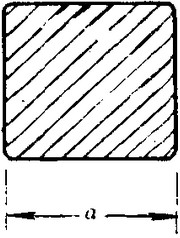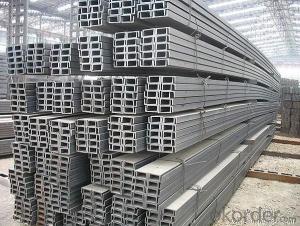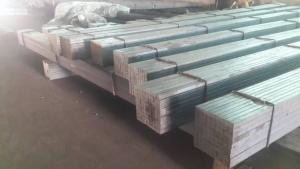Square bar 5mm-100mm
- Loading Port:
- China Main Port
- Payment Terms:
- TT OR LC
- Min Order Qty:
- -
- Supply Capability:
- -
OKorder Service Pledge
OKorder Financial Service
You Might Also Like
Product Description:
We offer Square Steel Bar with grade Q195 / Q235
Specifications of Square Steel Bar:
-Standard: GB,
-Grade: Q195/Q235 or equivalent.
Chemical Composition:
-Chemical Composition. Q195
Standard | Grade | Element (%) | ||||
GB | Q195 | C | Mn | S | P | Si |
0.06~0.12 | 0.25~0.50 | ≤0.050 | ≤0.045 | ≤0.30 | ||
-Chemical Composition. Q235
Standard | Grade | Element (%) | ||||
GB | Q235B | C | Mn | S | P | Si |
0.12~0.20 | 0.30~0.70 | ≤0.045 | ≤0.045 | ≤0.30 | ||
Measures and Tolerances of Square Steel Bar:

(The section of Square Steel Bar)
-The length of a side and the theoretical weight of Square Steel.
Length of a side(a, mm) | Theoretical weight(kg/m) | Length of a side(a, mm) | Theoretical weight(kg/m) |
6 | 0.283 | 32 | 8.04 |
7 | 0.385 | *33 | 8.55 |
8 | 0.502 | 34 | 9.07 |
9 | 0.636 | *35 | 9.62 |
10 | 0.785 | 36 | 10.17 |
11 | 0.950 | 38 | 11.24 |
12 | 1.13 | 40 | 12.56 |
13 | 1.33 | 42 | 13.85 |
14 | 1.54 | 45 | 15.90 |
15 | 1.77 | 48 | 18.09 |
16 | 2.01 | 50 | 19.63 |
17 | 2.27 | 53 | 22.05 |
18 | 2.54 | *55 | 23.6 |
19 | 2.82 | 56 | 24.61 |
20 | 3.14 | *58 | 26.4 |
21 | 3.46 | 60 | 28.26 |
22 | 3.80 | 63 | 31.16 |
*23 | 4.15 | *65 | 33.17 |
24 | 4.52 | *68 | 36.3 |
25 | 4.91 | 79 | 38.49 |
26 | 5.30 | 75 | 44.16 |
*27 | 5.72 | 80 | 50.24 |
28 | 6.15 | 85 | 56.72 |
*29 | 6.60 | 90 | 63.59 |
30 | 7.06 | 95 | 70.85 |
*31 | 7.54 | 100 | 78.50 |
Notes:
1, The theoretical weights in the list, base on the density of 7.85 g/cm3.
2, The numbers with *mean that they are not regulars or we don’t offer them.
-The allowed tolerance of Square Steel:
Length of a side(mm) | Allowed Tolerance | ||
Group1 | Group2 | Group3 | |
5.5~7 | ±0.20 | ±0.30 | ±0.40 |
7~20 | ±0.25 | ±0.35 | ±0.40 |
20~30 | ±0.30 | ±0.40 | ±0.50 |
30~50 | ±0.40 | ±0.50 | ±0.60 |
60~80 | ±0.60 | ±0.70 | ±0.80 |
80~110 | ±0.90 | ±1.0 | ±1.1 |
110~150 | ±1.2 | ±1.3 | ±1.1 |
150~190 | ―― | ―― | ±2.0 |
190~250 | ―― | ―― | ±2.5 |
Usage/Applications of Steel Square Bar:
-The Square Steel is normally used as structure steel.
-Row material for other structure steel like steel angles, channels, I-beams, H-beams, etc…
Packaging & Delivery of Steel Square Bar:
-Packing Detail: The products can be packed in bundles by steel wires.
-Marks:
1, Tag marks: the tag marks will be tied up to each bundle of the products. The information is usually including supplier’s logo and name, product name, made in China, products’ specifications, the painted color and other information requested by customers.
2, Color marks: we will paint both ends of the bundles of these products to make sure that they are more evident. It’s will be more convenient for the customers to distinguish them at the destination port.
-Delivery Detail: 30~45 working days after receive buyer’s T.T. or L/C.
Transportation:
-The products can be delivered by bulk vessel or by container. As for container, products with the length of 6m will be loaded in 20’ container, with 9m or 12m, in 40’ container.
-The maximum quantity of loading of container is 25 tons.
-The products usually are transported to the nearest port from the production place.
Payment:
-Invoicing on theoretical weight or actual weight a s customer’s request.
-FOB, CFR or CIF.
-Regular terms of payment:
1, 30% payment in advance, the remaining balance (70% payment) against the copy of B/L.
2, 30% payment in advance, the remaining balance (70% L/C) against the copy of B/L.
3, Negotiable.
- Q:How do you use a steel square to lay out a valley rafter?
- To lay out a valley rafter, one must follow the following steps: 1. Begin by determining the pitch of the roof, which is the ratio of the rise to the run. Typically presented as a fraction like 6/12 or 8/12. 2. Place the steel square on a flat surface, ensuring that the long edge is facing up and the shorter edge is pointing towards you. 3. Locate the line on the blade that corresponds to the roof pitch, often labeled with the pitch ratio. For instance, if the pitch is 6/12, locate the line labeled "6" on the blade. 4. Position the steel square onto the valley rafter stock, aligning the tongue with the rafter's edge. 5. Trace along the edge of the tongue to mark the plumb cut, representing the cut that will fit against the ridge board at the top of the rafter. 6. Proceed to trace along the edge of the blade to mark the bird's mouth cut, signifying the cut that will fit against the wall or supporting structure at the bottom of the rafter. 7. Measure and mark the length of the rafter from the plumb cut to the bird's mouth cut. 8. Repeat these steps for the opposite side of the valley rafter if necessary. 9. Finally, use a saw to accurately and precisely cut along the marked lines. By employing a steel square for laying out a valley rafter, one can ensure that the cuts are appropriately aligned, resulting in a secure fit and contributing to a structurally sound and visually appealing roof.
- Q:Can a steel square be used for checking the squareness of a jointer fence?
- No, a steel square cannot be used for checking the squareness of a jointer fence. A jointer fence is typically made of cast iron, and using a steel square would not provide accurate results. It is recommended to use a precision square that matches the material of the jointer fence, such as a cast iron square, to ensure precise and accurate measurements. Using the correct tool for the job is essential to achieve a properly squared jointer fence, which is crucial for accurate and precise woodworking.
- Q:What are the different techniques for using a steel square in metal fabrication?
- There are several techniques for using a steel square in metal fabrication. Some common techniques include measuring and marking angles, checking for squareness, and laying out or transferring measurements accurately. The steel square can be used to measure and mark precise angles by aligning it with the workpiece and drawing lines accordingly. It can also be used to check for squareness by comparing the perpendicularity of different edges or corners. Additionally, the steel square is useful for laying out or transferring measurements accurately by using its straight edges and right angles as reference points. Overall, the steel square is a versatile tool that aids in achieving accuracy and precision in metal fabrication processes.
- Q:Can a steel square be used for marking out tenon shoulders?
- Tenon shoulders can be marked out using a steel square. A steel square, also referred to as a try square, is a commonly used woodworking tool for layout and marking. Its straight edge and 90-degree angle make it perfect for precise and accurate line marking. In order to achieve a well-fitted tenon joint, it is crucial to ensure that the lines are perpendicular to the wood's face and edge. This can be achieved by aligning the straight edge of the steel square with the wood's face and edge, and then marking the shoulder lines along the square's edge. By doing so, the tenon's shoulders will be square and straight, resulting in a sturdy and well-fitted joint.
- Q:Can a steel square be used for checking the plumbness of poles?
- No, a steel square cannot be used for checking the plumbness of poles. A steel square is primarily used for measuring right angles and making straight cuts, whereas checking plumbness requires a level or plumb bob to determine vertical alignment accurately.
- Q:How do you use a steel square to measure and mark 120-degree angles?
- To use a steel square to measure and mark 120-degree angles, you need to align the 60-degree angle on the square with one of the sides of the angle you want to measure. Then, mark a point where the other side of the angle intersects the steel square. Finally, use a straight edge to connect this point with the vertex of the angle, creating a 120-degree angle.
- Q:How do you use a steel square for creating accurate half-lap joints?
- To use a steel square for creating accurate half-lap joints, follow these steps: 1. Measure and mark the desired length of the half-lap joint on both pieces of wood. 2. Place the steel square on one of the marked lines, aligning one edge of the square with the mark. 3. Draw a line along the other edge of the square, extending it to the end of the wood piece. 4. Repeat this process on the other piece of wood, ensuring the lines are parallel. 5. Use a saw to carefully cut along the marked lines, ensuring the cuts are straight and accurate. 6. Test-fit the two pieces together to check the accuracy of the joint. Make any necessary adjustments if the fit is too tight or loose. 7. Once satisfied with the fit, glue or fasten the joint together securely.
- Q:How do you use a steel square to lay out a hip rafter?
- To use a steel square to lay out a hip rafter, you would first determine the pitch of the roof and mark it on the square. Then, align the pivot point of the square with the plumb cut line on the hip rafter, and use the markings on the square to determine the lengths and angles for the hip rafter's cuts. This will help you accurately position and cut the hip rafter to fit the specific roof design.
- Q:How do you use a steel square to measure the width of a picture frame?
- To use a steel square to measure the width of a picture frame, you will need to follow a few simple steps. First, ensure that your steel square is clean and free from any dirt or debris that could affect your measurements. Next, place the steel square against one side of the picture frame, aligning it with the edge of the frame. Make sure that the square is flush against the frame and not tilted or slanted in any way. Once the steel square is properly positioned, use the measuring scale on the square to determine the width of the frame. Read the measurement value where the other side of the frame intersects with the scale on the square. It is important to note that steel squares typically have both metric and imperial measurements, so ensure you are using the appropriate scale for your needs. Repeat this process on the opposite side of the frame to validate your measurement. If the frame is not perfectly square, take multiple measurements at different points and use the average to get a more accurate width. Overall, using a steel square to measure the width of a picture frame is a straightforward process that provides accurate results, making it a reliable tool for this purpose.
- Q:Can a steel square be used for tile work?
- Yes, a steel square can be used for tile work. It can be a useful tool for measuring and marking tiles accurately, ensuring precise cuts and angles.
1. Manufacturer Overview |
|
|---|---|
| Location | |
| Year Established | |
| Annual Output Value | |
| Main Markets | |
| Company Certifications | |
2. Manufacturer Certificates |
|
|---|---|
| a) Certification Name | |
| Range | |
| Reference | |
| Validity Period | |
3. Manufacturer Capability |
|
|---|---|
| a)Trade Capacity | |
| Nearest Port | |
| Export Percentage | |
| No.of Employees in Trade Department | |
| Language Spoken: | |
| b)Factory Information | |
| Factory Size: | |
| No. of Production Lines | |
| Contract Manufacturing | |
| Product Price Range | |
Send your message to us
Square bar 5mm-100mm
- Loading Port:
- China Main Port
- Payment Terms:
- TT OR LC
- Min Order Qty:
- -
- Supply Capability:
- -
OKorder Service Pledge
OKorder Financial Service
Similar products
New products
Hot products
Related keywords



























